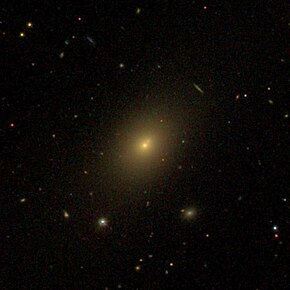NGC 359 is an elliptical galaxy located approximately 238 million light-years from the Solar System[2] in the constellation Cetus. It was discovered on September 2, 1864, by Albert Marth. It was described by Dreyer as "extremely faint, very small."[4]
| NGC 359 | |
|---|---|
 SDSS view of NGC 359 | |
| Observation data (J2000 epoch) | |
| Constellation | Cetus |
| Right ascension | 01h 04m 16.9s[1] |
| Declination | −00° 45′ 54″[1] |
| Redshift | 0.017803[1] |
| Heliocentric radial velocity | 5,337 km/s[1] |
| Distance | 238 Mly[2] |
| Apparent magnitude (V) | 14.3g[1] |
| Characteristics | |
| Type | E0[3] |
| Apparent size (V) | 1.10' × 0.78'[1] |
| Other designations | |
| UGC 00662, CGCG 384-066, MCG +00-03-066, 2MASX J01041697-0045532, 2MASXi J0104169-004555, PGC 3817.[1] | |
This elliptical galaxy has an extremely long tidal tail and shell structure, seen across several deep-sky surveys, indicating a likely-recent and possibly ongoing interaction with nearby galactic neighbor NGC 364.
See also edit
References edit
- ^ a b c d e f g "NASA/IPAC Extragalactic Database". Results for NGC 0359. Retrieved September 2, 2016.
- ^ a b An object's distance from Earth can be determined using Hubble's law: v=Ho is Hubble's constant (70±5 (km/s)/Mpc). The relative uncertainty Δd/d divided by the distance is equal to the sum of the relative uncertainties of the velocity and v=Ho
- ^ "NGC 359". SIMBAD. Centre de données astronomiques de Strasbourg. Retrieved January 1, 2017.
- ^ "New General Catalog Objects: NGC 350 - 399". Cseligman. Retrieved November 19, 2016.
External links edit
- Media related to NGC 359 at Wikimedia Commons
- NGC 359 on WikiSky: DSS2, SDSS, GALEX, IRAS, Hydrogen α, X-Ray, Astrophoto, Sky Map, Articles and images
- SEDS